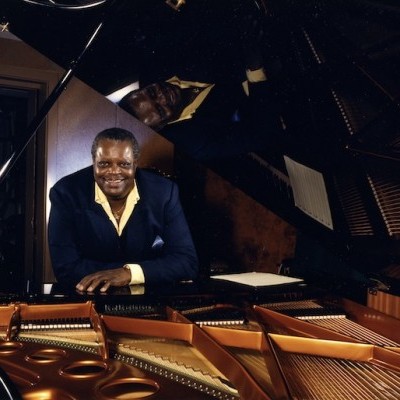Dec 9, 2025 12:28 PM
In Memoriam: Gordon Goodwin, 1954–2025
Gordon Goodwin, an award-winning saxophonist, pianist, bandleader, composer and arranger, died Dec. 8 in Los Angeles.…

“I’ve made some big changes from pre-COVID to post-COVID Lucy,” Yeghiazaryan said.
(Photo: Shervin Lainez)Nearly three years after the world locked down, artists continue exploring resonances of solitude in their music. On her February release Lonely House (La Reserve), Lucy Yeghiazaryan probes acute feelings of disbelief, exhaustion, boredom and sadness, as well as profound changes in self-acceptance, perspectives on aloneness and how she approaches her craft.
“I’ve made some big changes from pre-COVID to post-COVID Lucy,” says the Manhattan-based singer. Allowing those changes to enter every corner of her artistry, she enters a new realm of intimacy and disclosure.
Developed over many months, Lonely House features an exposed dialogue between Yeghiazayran and her longtime collaborator, pianist and composer Mike Kanan. Known for deep musical phrasing and a penchant for conversational improvising, Yeghiazaryan reveals another layer of expression on Lonely House — one that’s equally musical, but more personal. Determined to hold sonic space for her proclivities and imperfections, she finds sound amid silence and evolution in solitude.
“We’re living in an age where you can edit out and you can present a falsified product,” she says. “And I wanted [this record] to be very raw.” The artists rehearsed for months, leaving long stretches between sessions due to the pandemic. But even sporadic interactions proved motivating for Yeghiazaryan, who praises Kanan as “the most cushiony, comfortable accompanist.”
After hearing its 1959 rendering on Abbey Lincoln’s Abbey Is Blue (Riverside), the title track would inspire the entire album. “It has such a heavy mood to it,” says Yeghiazaryan. “And it describes the experience of living in an apartment in New York so acutely: What does it feel like when inanimate objects become living somehow when you’re all by yourself? I thought, I gotta put out a record.”
She began collecting songs that felt related thematically, exploring the myriad emotions she felt while hunkered down in Harlem. “Cottage For Sale” echoes the melancholy mood of discord and separation many couples experienced. “It had been years since I heard a track that made me cry,” she says, “but it brought tears to my eyes.” When friends, neighbors and colleagues left the city, she grappled with feelings of envy, channeling them satirically through “It’s So Peaceful In The Country.” Her slow swing delivery of “Easy Street” provides a truthful account of her thoughts when clubs and venues began to reopen.
A false starkness belies layers of activity and intention across Lonely House. Yeghiazaryan opted out of using studio booths. “Traditionally, all the big Blue Note records were done in the main room. And I’ve [recorded] my last couple projects in the main room.” After the session, she found she couldn’t rely on edits to manipulate the sound. “Everyone’s bleeding into everyone else’s microphone — I couldn’t even get the sound of the piano pedals out,” she says.
But the rawness of each track becomes a comment on the era. Errors and uncertainties, together with a strong desire to reach out and connect with other people, have become an intrinsic part of pandemic culture.
Arrangements solidified over time. “Every time [Mike and I] met, our mood was different and the tunes sounded different,” says Yeghiazaryan, “but it slowly settled in.” She views their joint approach to arranging as minimal. But even minimalism requires action. And as a result of certain subtleties, surrealism pervades the music.
Of the album’s near dozen compositions, few would become gig tunes. “Most of these, I don’t perform live,” says Yeghiazaryan. “I learned them for the record.” Consequently, the music moves at a similar tempo from one track to the next, the most lively being a medium-swing arrangement of “Ill Wind.” Admittedly, she felt nervous before the release date. “It’s very exposed and I was worried that people wouldn’t find it interesting,” she says. “I find that a lot of entertainment has to be overly stimulating today to catch any kind of attention.” So far, however, album reception has been positive.
“I think the following that I have, as small as it may be, likes me because I don’t edit,” she says. “I’m keen on presenting vocal performance on a record as if it were live. I’m committed to that cause because the greats who made this music what is was did that. It was raw and it was real. I want to continue the tradition in that sense.”
Lonely House signals a new invention of Yeghiazaryan’s artistry. “This [record] is the first example of me exploring the lyric and allowing it to influence what I was singing,” she says. “This album gave me the opportunity to discover myself as an English-speaking singer, where everything was built around the lyric rather than the other way around.”
Through Lonely House, Yeghiazaryan invites listeners to reconnect with themselves: “You find a whole new world when you’re silent with yourself. You just have to give yourself time to start hearing the things within that silence.” DB

Goodwin was one of the most acclaimed, successful and influential jazz musicians of his generation.
Dec 9, 2025 12:28 PM
Gordon Goodwin, an award-winning saxophonist, pianist, bandleader, composer and arranger, died Dec. 8 in Los Angeles.…

Nov 13, 2025 10:00 AM
For results of DownBeat’s 90th Annual Readers Poll, complete with feature articles from our December 2025 issue,…

Flea has returned to his first instrument — the trumpet — and assembled a dream band of jazz musicians to record a new album.
Dec 2, 2025 2:01 AM
After a nearly five-decade career as one of his generation’s defining rock bassists, Flea has returned to his first…

To see the complete list of nominations for the 2026 Grammy Awards, go to grammy.com.
Nov 11, 2025 12:35 PM
The nominations for the 2026 Grammy Awards are in, with plenty to smile about for the worlds of jazz, blues and beyond.…

“It’s a pleasure and an honor to interpret the music of Oscar Peterson in his native city,” said Jim Doxas in regard to celebrating the Canadian legend. “He traveled the world, but never forgot Montreal.”
Nov 18, 2025 12:16 PM
In the pantheon of jazz luminaries, few shine as brightly, or swing as hard, as Oscar Peterson. A century ago, a…